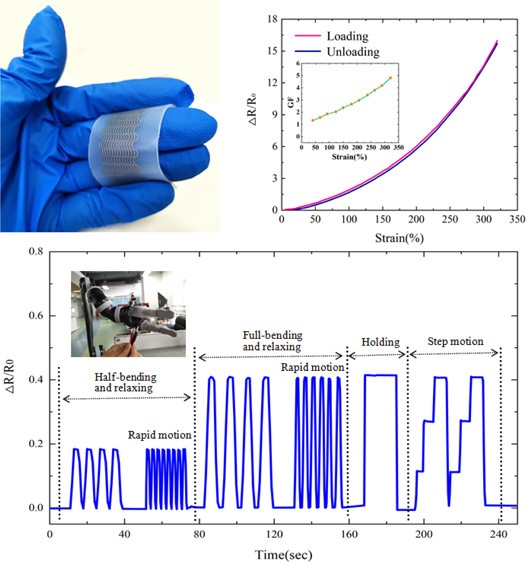Scientists Design Microfluidic Flexible Strain Sensor Based on Wave-Patterned Liquid Metal
Date:03-06-2020 | 【Print】 【close】
Flexible strain sensor has become the key research direction for the development of intelligent devices in the future. It has broad application prospects in the fields of human-computer interaction systems, electronic skin and human motion behavior monitoring systems, etc.
Among them, Flexible strain sensors have been widely used in wearable electronic devices for body physical parameters capturing. However, regardless of the stretchability of sensing material, the resolution of small strain changes, or the hysteresis between loading/unloading states, has always limited the various applications of these sensors.
A Research team led by Prof. LI Hui and Prof. WANG Lei from the Shenzhen Institutes of Advanced Technology (SIAT) of the Chinese Academy of Sciences developed a microfluidic flexible strain sensor by introducing liquid metal eutectic gallium indium (EGaIn) embedded into wave-shaped microchannel elastomeric matrix. The novel wave-shaped design of the microchannels reduced the viscoelasticity, increased deformation recovery capability, and improved the hysteresis either.
This work has been published in ACS Applied Materials & Interfaces.
This flexible strain sensor could withstand a strain up to 320%, and the hysteresis performance was also improved from 6.79% to 1.02% by the wave-patterned structure which could restrain the viscoelasticity of elastomer effectively.
Moreover, an enhanced wavy-shaped strain sensor was fabricated by increasing the length of microfluidic channel, it has highly sensitivity (GF=4.91) and resolution, even as low as 0.09% strain change could be detected, which was capable of resolving microdeformation. Besides, the enhanced wavy-shaped strain sensor exhibited quick response time (t=116ms).
Through thoroughly evaluation of the performance, a series of key indicators demonstrated that the enhanced wave-shaped strain sensor has excellent mechanical compliance, showed promising for wearable electronic, motion recognition, healthcare and soft robotics.

Fig 1. The images of enhanced wavy-shaped strain sensor. (a) Optical image of the enhanced liquid metal based microfluidic strain sensor. (b) Images of the enhanced strain sensor shows: thinness, comfortability, flexibility and bendability. (Image by SIAT)

Fig 2. (Above) The microfluidic sensor can withstand a strain of up to 320%; (Below) Demonstration of functionalities of the enhanced microfluidic sensor as a wearable device for monitoring human and robot motions in real time. (Image by SIAT)
Media Contact:
ZHANG Xiaomin
Email: xm.zhang@siat.ac.cn